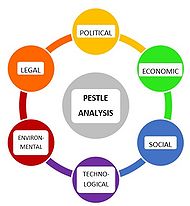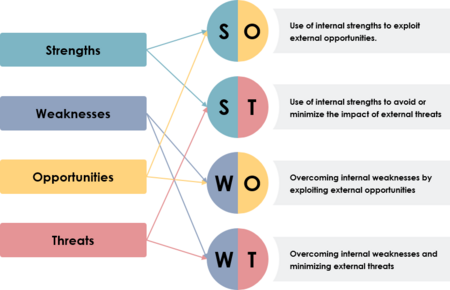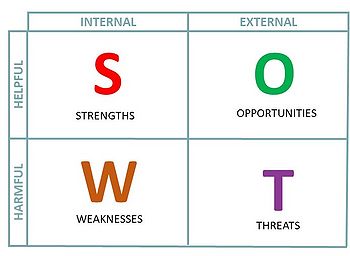SWOT Analysis Framework
SWOT is an abbreviation for Strength Weakness Opportunities and Threats. It is a visual analysis framework used to evaluate a company's competitive position. It's used early in the decision-making process to secure smooth future planning. Some credit is given to George Albert Smith Jr and C Roland Christiensen, both professors at Harvard Business School Policy Unit during the early 1950s. Some sources also mention another Harvard Business School Policy Unit professor Kenneth Andrews for his usage and application of it later in the 1950s. But most often the management consultant at Stanford Research Institute Albert Humphrey will be given credit for its invention in the 1960s, though he does not acknowledge the credit himself.[1]
A SWOT analysis is conducted by creating a 4-quadrant diagram and labeling the contributing strengths, weaknesses, opportunities, and threats, and critically examining them. This is done by assessing external and internal factors in combination with relevant potential. The analysis categorizes internal, external, positive, and negative factors. The strengths are positive and the weakness is negative internal factors. The opportunities are positive and the threats are negative external factors. Internal factors can be found within the business or company itself, whereas external factors can be found using other analysis tools such as PESTLE Analysis or Porter's Five Forces. When this is done the objectives of the business venture or project should be specified. The creator of SWOT analysis is forced to consider the core obstacles and how to overcome them, this makes it a strong tool for overall strategy. It has a very simple structure. The simple structure can be an advantage or a disadvantage depending on the use of the framework. If used correctly it can be a reliable tool for establishing the company's position. If not used correctly it can develop inconsistently. This article will also briefly focus on TOWS analysis and other alternatives or interpretations of the SWOT. A TOWS analysis is developed with the same approach as the SWOT analysis but focuses on the external analysis first opposite of the SWOT analysis which focuses on the internal factors first.[2]
Contents |
Overview
The concept of SWOT analysis is simple: to highlight the areas in which you wish to improve and minimize the areas where errors can occur. It’s an important tool because it can help identify which later steps in planning are necessary to achieve the objective. It also contributes to realizing if the objective is attainable or not. If not then the process must be repeated by selecting a different objective. SWOT is an acronym for Strength Weakness Opportunities and Threats.[3] Each category must be filled out starting with the internal factors, strengths, and weakness:
Strength: the characteristics that give the business an advantage over the competition. Look within the company and find every strength that secures the position on the market. Strengths can be flexible such as brand attributes or more general like a specific team or branch. It can also be strengths in a particular product or product development which could give a market advantage.
Weakness: the characteristics which give the business a disadvantage over the competitors. This is a great opportunity for critical self-awareness. Weaknesses can be within the company, like lack of specialized personnel or lack of resources either in form of financials or maybe production requires specific materials which are difficult to attain. It may also be concerning other companies; is the company’s market presence or reputation strong enough to withstand competition.[4]
When strengths and weaknesses within the business have been identified it is time to move on to the external factors, opportunity, and threats:
Opportunity: external factors that could contribute to your growth. In this step, there will be looked at every area where there is potential for growth or improvement and finding the factors that can contribute to it. Which opportunities can be utilized to secure or advance the position on the market? It can also be purely financial advancement or opportunity to hire new experienced workers. The primary purpose of opportunity is to find factors that can be turned into strengths for the company in the future.[4]
Threats: external factors that can harm the business or project. This could include new businesses that could become competitors or new laws that might affect them. It can be a very broad section of the analysis depending on how detailed you wish to be and how big impact threats you want to include.
SWOT considers the external and internal factors as well as which factors are helpful or harmful. The weaknesses and threats are harmful while strengths and opportunities categorize as helpful.[5]
Internal factors
The internal factors can be found within the company itself; this could include factors such as finance, technology, reputation, or marketing. These factors can give the company an advantage or disadvantage depending on how well maintained or strong they are. Internal factors can be found in any corner of the business depending on what the purpose of the SWOT analysis is. For example, if the purpose is to grow within its own market it could be relevant to look into if any previous experience. If there have been developed new products of development to contribute to the market. These can help identify what the strength in growth could be or if there are any weaknesses to be aware of.
External factors
External factors are found outside the business. It can be helpful to use other analysis tools such as PESTLE Analysis or Porter's Five Forces.
PESTLE
PESTLE is also an acronym short for Political, Economic, Social, Technological, Environment, and Legal. When completing a PESTLE analysis it is an advantage to incorporate the entire team to ensure as many aspects and viewpoints as possible.[6] The analysis is used as an external analysis when either looking at market research or as strategic analysis. The analysis is carried out by going through each of the six areas and list everything which could affect the company:

- Political is any effect the government or other political factor can have on the economy by changing areas like taxes, laws, trade restrictions, etc. Keep in mind that the government also can have an impact on the health and education system.
- Economic is any factor that can affect the economical positions. This factor includes rates for exchange, interest, inflation but also general economic growth.
- Social is the anthropological factor. In this area, everything social like cultural aspects or population growth rate is included.
- Technological is everything development and automation. What technological developments could affect the business or is it possible to include automation methods that could contribute.
- Environmental is the climate. This area is focused on the weather, climate change, and ecological aspects and how changes could affect the company by affecting tourism, farming, etc.
- Legal is in-depth of some of the points from political. In this area, all the focus is on the laws which can affect the company.
The PESTLE is an excellent tool to use because it's a straightforward framework, although it's essential to be aware of not oversimplifying the amount of data used for decisions. After completing a PESTLE analysis the company will have a good general idea of the factors outside of the business and whether or not they can be used as opportunities or will develop into threats.[8]
Porter’s Five Forces
Porter’s Five Forces aims to understand the competitiveness of the business and identify potential profitability. When having identified external forces that can affect profitability it is possible to create opportunities for the business.[9]
The five forces are:
- Rivalry among existing competitors looks at the existing competitors in the market. First identify the competitors that could affect your market: how many are there, what are their strengths and weaknesses, does the quality of their product compare to your product. These thoughts will help identify the companies market position if there are many competitors it could lead to price conflicts and the consumer would always have alternatives. If there is not a lot of competition and the company has a unique product, then there will be little force but likely a good profit and strength.
- Bargaining power of suppliers looks at how much force the suppliers can affect the company. Identify the relationship with the supplier: how many suppliers are present, how much power do they have to determine the prices, what do they cost and how expensive would it be to change the supplier. If there are few specialized suppliers they can have a lot of power to affect the company. Consider distributing your suppliers more widely to avoid giving a lot of power to a small group.
- Bargaining power of buyers looks at the buyers of your product. Some relevant actions could be to identify how many buyers there are for your product and how many alternative products they can access at rivalry companies. If there is a large and stable customer group the company has more power compared to a small group with a large expenditure.
- The threat of substitute products or services combines the rivalry and buyers force. This step is used for identifying how likely it is that the customer will find a substitution for the product either by doing it manually or by outsourcing it.
- The threat of new entrants looks at the risk of new entries to the market. Identify how much the company would be affected if a new similar product entered the market. If it's cheap and easy for new products to enter you want to consider how to solidify a favorable position and take advantage of it.
Application
SWOT analysis is generally used early in the process as a technique for strategic planning. It can sometimes also be used to make a business case because will collect large portions of relevant information that could contribute to the market research or competition identification. SWOT is a good opportunity to brainstorm within the business to assess the general position on the market and to clarify the objectives of a business venture or project. This is done by identifying the internal and external factors that are supportive or damaging to achieve these objectives. The key points of a SWOT application are to identify the internal and external barriers which could limit the objectives but to also determine the factors which could benefit the objective and thereby decide on a course of action that will be most powerful.[10][11]
It is a visual tool and be completed in a few steps. Before beginning the process consider gathering all of the key stakeholders or others close to the project. The first step is to collect information internally. Gather and list all the strengths and weaknesses available here and now. It can be an advantage to conduct interviews or brainstorms to ensure everything is gathered. It is important to be realistic but also make sure to not overrule any details.
The second step is making a thorough list of all the opportunities and threats that could occur externally in the future. The opportunities listed here could be turned into future strengths and the threats could develop into weaknesses. It is important to exploit the opportunities to turn them into strengths while also changing or stopping the threats to avoid having them turn into weaknesses. When going through the steps make sure to prioritize the factors from most important to least important.
It is also in this step where a PESTLE analysis of Porter’s Five Forces can be done to ensure that all external factors are included. The final part of a SWOT analysis is the plan of action. Take a step back after brainstorming and prioritizing and review the matrix. Then make a detailed plan to maintain the current strengths and minimize the threats. Then create plans to turn opportunities into strengths and plan how to avoid threats turning into future weaknesses. This is perhaps the biggest strength of the SWOT analysis, to not only list the strengths and weaknesses but to establish and implement actual timelines for conceivable solutions.[12]
It is important to continuously maintain SWOT afterward. This is to ensure that the priorities at the top of the list are always the most current and most important factors. If anything has changed in the position, make sure to return and reassess if there have been changes or you need to include or exclude any factors.[13]
Limitations
SWOT is most beneficial to use for small businesses because there is often more responsibility on the owner alone instead of having large corporate departs to help with support in growing, developing, and maintaining the business. SWOT can therefore help the manager of the small business in the decision-making process. SWOT analysis should not be a contributing tool in decision-making, its main intention is a starting point for discussions and clarification in regards to the business’ position.[14][15]
A SWOT analysis will only show a moment in time, and it requires continuous work to maintain and update the analysis to be accurate. This can be a large disadvantage in an agile environment.[16]
Another disadvantage is the subjectiveness of it. Different departments or stakeholders may perceive a listed opportunity as a threat or vice versa. Therefore, it is crucially important that all relevant personnel contribute to the completion of the analysis. This could potentially be a disadvantage in a large business as well because it will be difficult to gather everyone involved.[17]
SWOT Alternatives
Telescopic Observations Strategic Framework (TOSF)
Telescopic observations var introduced by George Panagiotou, Riëtte van Wijnen in 2005. TOSF aims to re-invent the original SWOT analysis by “enhancing intelligence gathering and improving strategic marketing planning in practice”. They believed their enhancement would create a more extensive result with more focus on the strategic direction.[18]
TOWS
TOWS is an extension of the SWOT analysis. SWOT starts by focusing on the internal factors, but a TOWS analysis will focus on the external factors such as opportunities and threats first. SWOT is primarily used for planning; TOWS will primarily be used for planning action.[19]
TOWS uses the original four categories strengths, weaknesses, opportunities, and threats but combines them into four new categories:
Strengths/Opportunities: as mentioned in the SWOT section opportunities can be turned into strengths later in the process. In the TOWS analysis, you make a plan as to how you will turn the opportunity into strength to capitalize on each external opportunity.
Strength/Threats: all the strengths are considered and decide how to use the internal strengths to avoid the external threats.
Weaknesses/Opportunities: switch focus and look at all the weaknesses you’ve listed in the SWOT analysis. The purpose of this is to identify how many internal weaknesses can be eliminated by using external opportunities.
Weaknesses/Threats: in this section, you focus on all the negative, internally and externally, and how these weaknesses and threats can be eliminated or avoided beforehand.

SOAR
SOAR is an acronym for Strengths, Opportunities, Aspirations, and Results. It has quite a lot of resemblance to the SWOT analysis. The key difference is the SWOT focuses both on current positive factors but also where there is room for improvement and weaknesses. The SOAR analysis's primary focus is on positive factors and visions for the future. It is a good tool when you want to encourage your team and find a plan for future growth and visions. [21][22]
References
- ↑ History of SWOT Analysis
- ↑ TOWS Matrix
- ↑ Piercy, N. and Giles, W. (1989) Making SWOT Analysis Work Journal of Marketing Intelligence & Planning, Vol 7, Issue 5/6, P 5-7
- ↑ 4.0 4.1 "https://www.wordstream.com/blog/ws/2017/12/20/swot-analysis How to Do a SWOT Analysis for Your Small Business"
- ↑ Panagiotou, G. (2003) Bringing SWOT into Focus, Business Strategy Review, Vol 14, Issue 2, pp8-10.
- ↑ PESTLE analysis
- ↑ Scanning the Environment Pestel Analysis.//Accessed February 20th 2021
- ↑ What is PESTLE Analysis?
- ↑ Porter's Five Forces Understanding Competitive Forces to Maximize Profitability
- ↑ How to Perform a SWOT Analysis
- ↑ Attrup, M. L. and Olsson, J.R. , Power i projekter og portefølje, DJØF Publishing (2008), ISBN: 978-87-574-1665-7
- ↑ SWOT Analysis Made Simple – History, Definition, Tools, Templates & Worksheets
- ↑ Tips for Conducting a SWOT Analysis
- ↑ Dess, Gregory (2018). Strategic Management. United States: McGraw-Hill
- ↑ Dealtry, R. (1992) Dynamic SWOT Analysis, DSA Associates, Birmingham, Haberberg, A. (2000), “Swatting SWOT”, Strategy, (Strategic Planning Society), September.
- ↑ Hill, T. & R. Westbrook (1997), “SWOT Analysis: It’s Time for a Product Recall,” Long Range Planning, 30
- ↑ The SWOT is Dead.
- ↑ The “telescopic observations” framework: an attainable strategic tool
- ↑ TOWS Model Analysis – SWOT with actions
- ↑ TOWS Analysis: A Comprehensive Guide
- ↑ SOAR Analysis Template & Example
- ↑ S-O-A-R with Your Board

